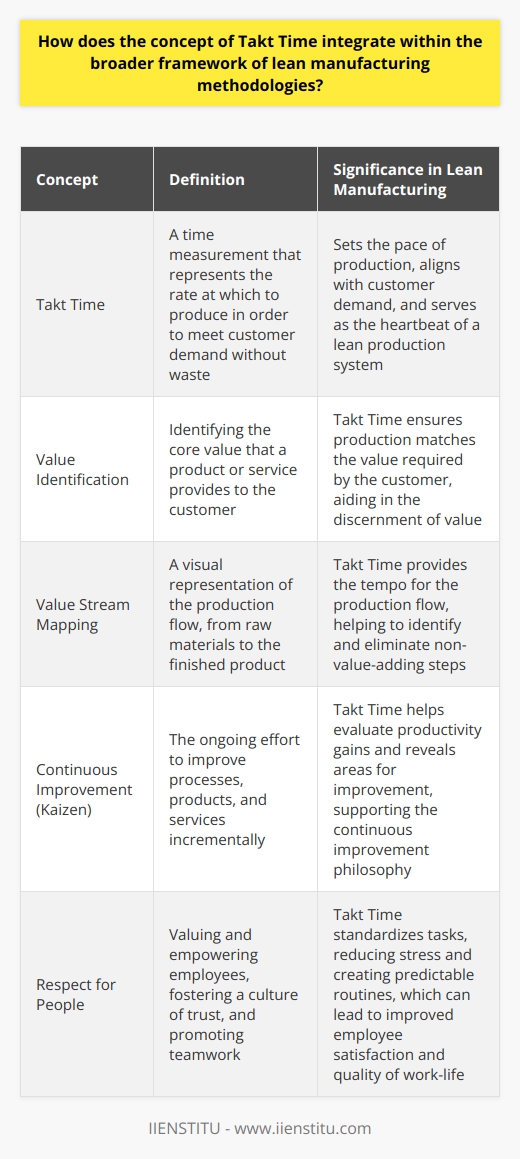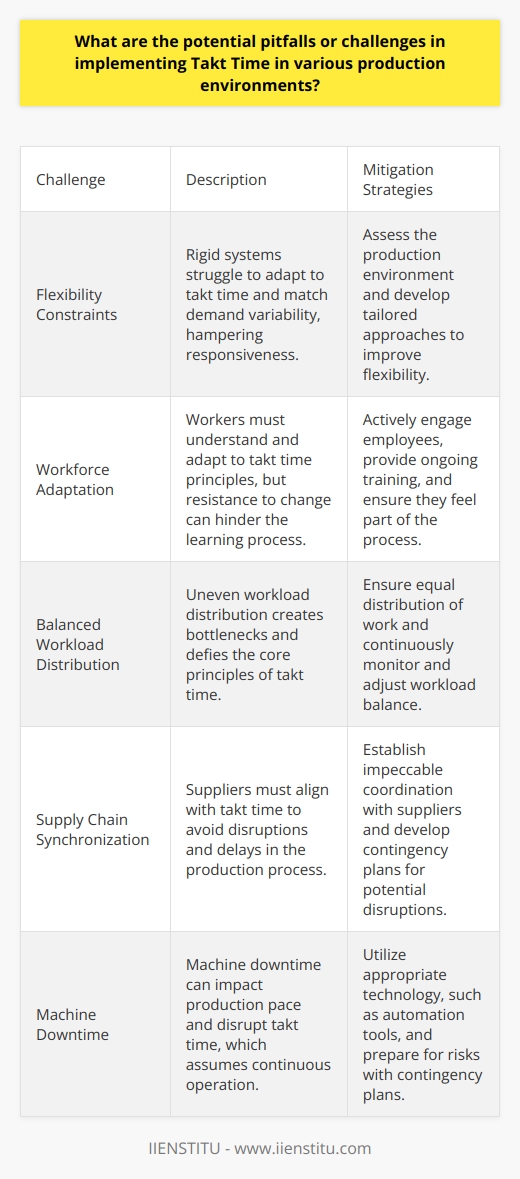
In the competitive environment of modern production, efficiency and rhythm are pivotal to success. Companies relentlessly seek to hone their operations, aspiring for a zenith of productivity that matches demand with an almost musical precision. Such synchrony is not a matter of chance but an outcome of meticulously adopted strategies within the realm of lean manufacturing. A quintessential element in this symphony of efficiency is Takt Time, a concept that revolutionizes how production paces itself in alignment with customer demand.
This blog post delves into the intricacies of Takt Time, from its foundational theory and calculation methods to its practical applications and the nuanced balance of its benefits and limitations. With a focus on real-world applications and a nod to the growing popularity of online certificate programs, including the problem-solving certificate, this post aims to impart a comprehensive understanding of how Takt Time functions as an instrumental facet of production strategy.
Introduction to Takt Time
Definition and Explanation of Takt Time
Takt Time is the heartbeat of lean manufacturing, a tempo that aligns production with the pace of customer demand. The term is derived from the German word 'Takt,' which refers to a musical meter or rhythm. In the context of production, Takt Time is the rate at which a product must be completed to meet customer demand. It is a vital metric for any business looking to synchronize its manufacturing processes with the ebb and flow of market requirements.
Understanding Takt Time is not just a matter of arithmetic; it is a philosophical embrace of the rhythm that governs the dance between supply and consumer need.
The Origin and Importance of Takt Time in Business
The ancestors of Takt Time can be traced to the automotive giant Toyota, where it played a central role in the esteemed Toyota Production System, a precursor to what is now known as lean manufacturing. The realization that syncing production with demand avoids overproduction and waste was revolutionary.
Takt Time's importance in business today cannot be overstated—it enables companies to respond swiftly to market conditions, reduces inventory costs, and minimizes wastage, thus enhancing overall efficiency and competitiveness.
Overview of the Blog Content
As we progress, this treatise will dissect the concept and methodology of calculating Takt Time, followed by an examination of its applications across varied scenarios. A contemplation of the strategy's virtues and potential drawbacks will ensue, concluding with a case study that paints a vivid picture of Takt Time's implementation in the real world.
This exposition aims to provide a rich narrative that underscores the immersive expertise and user-oriented approach that defines the field.
Concept and Calculation of Takt Time
Deep Dive into the Concept of Takt Time
Takt Time is not merely a measure of time but a reflection of a company's commitment to operational harmony. It forms the backbone of a production system that is responsive and adaptive, ensuring resources are harnessed efficiently. To truly grasp the gravity of Takt Time is to understand its role in streamlining processes, minimizing idle time, and setting a steady pace that workers and machines can follow with systematic predictability.
Explanation of How to Calculate Takt Time
Calculating Takt Time is critical for setting the tempo of production. The formula is seemingly simple: you divide the available production time by the number of units required by the customer. However, this calculation embodies more than just arithmetic—it is the translation of market demand into actionable manufacturing beats. Calculating Takt Time requires not only careful analysis of customer orders but also a keen understanding of production capabilities and time constraints.
Use of Real-life Examples for Calculation
Consider an electronics manufacturer tasked with producing 2,400 units of a device each month. If there are 160 hours of production time available, the Takt Time would be calculated as 160 hours divided by 2,400 units, equaling 4 minutes per unit. This example demonstrates that the company must complete one unit every 4 minutes to meet monthly demand. Such calculations, when applied to a real manufacturing environment, can drive home the practical implications of Takt Time on a production floor.
Importance of Understanding Takt Time in Resource Management
Resource management is a complex jigsaw, and Takt Time serves as the guide for placing the pieces. Aligning human labor, machinery, and material flow to the Takt Time ensures that resources are utilized effectively, without excess or shortage. Mastery of Takt Time calculation empowers businesses with the knowledge required to make informed decisions about staffing, equipment purchases, and production schedules.
Factors Affecting Takt Time
Discussion on Variables That Influence Takt Time
Takt Time is not a static figure; it is subject to the dynamic nature of production variables. Changes in customer demand, production capacity, operating hours, and even seasonality can all influence Takt Time. Manufacturers need to remain agile, ready to adjust their Takt Time in response to these fluctuations, ensuring the production line continues to hum with the rhythm of demand.
Explanation of How Business Type, Product or Service, Production Process, and Capacity Affect Takt Time
The type of business has a direct bearing on Takt Time. A custom furniture workshop, for instance, will have a different Takt Time compared to an automotive assembly line due to variances in product complexity and customer requirements. A service-based industry may calculate Takt Time based on different parameters, such as appointments or service calls, rather than physical products. The production process complexity and overall capacity also play crucial roles, influencing how Takt Time is established and maintained.
Applying Takt Time Calculation to Different Scenarios
Application of Takt Time in Different Business Sectors
Whether it's healthcare, manufacturing, or customer service, the principles of Takt Time are universally applicable. In healthcare, Takt Time could dictate the pace at which patients are seen, ensuring optimal throughput and resource use. In a call center, it could determine the average handling time required to meet customer demand peaks. Real-life application highlights the versatile nature of Takt Time, making it a valuable tool across various industries.
Using Examples to Demonstrate the Application of Takt Time in Real-life Situations
In a bakery, setting a Takt Time for the production of pastries ensures that fresh goods are ready as customers arrive through the morning rush. Similarly, in software development, Takt Time could be used to schedule the release of features in alignment with consumer expectations. These instances exemplify how Takt Time can serve as a linchpin for customer satisfaction across diverse business models.
Benefits and Limitations of Takt Time
Understanding the Benefits of Implementing Takt Time to Business Operations
Adopting Takt Time empowers businesses to optimize their workflows, reduce waste, and respond with agility to the shifting sands of market demand. This cadence not only improves efficiency but can also lead to significant cost savings and higher customer satisfaction. The rhythmic production facilitated by Takt Time creates a structured environment where continuous improvement becomes part of the organizational culture.
Discussing the Limitations or Drawbacks of Takt Time
Despite its advantages, Takt Time is not without its constraints. Strict adherence to Takt Time may lead to rigidity in the production process, making it challenging to adapt to sudden market shifts or custom requests. It can also place stress on employees as they strive to maintain the set pace, potentially leading to burnout or a compromise in quality.
Providing Expert Insight into Benefit-Cost Analysis
In weighing the benefits against the limitations, one must approach the implementation of Takt Time with a strategic mindset. Understanding the value of improved efficiency and customer alignment must be balanced against the need for flexibility and the well-being of the workforce. This benefit-cost analysis enables businesses to determine how rigidly they should adhere to Takt Time or whether allowances should be made for variability.
Increase in Productivity
Discussing How Takt Time Can Improve Productivity and Efficiency
Takt Time is a powerful driver of productivity as it eliminates guesswork and instills a consistent work rhythm. By aligning each aspect of production around a central time frame, the entire operation becomes more synchronized, leading to reduced transition times and enhanced flow efficiency. This focus on pacing can dramatically increase output while maintaining quality and meeting customer expectations.
Limitations Regarding Flexibility
Explanation of Possible Challenges in Takt Time Adoption - Flexibility and Unpredicted Variations
The strict scheduling imposed by Takt Time can backfire in the face of unforeseen variations. Machine breakdowns, staff shortages, or supply chain disruptions can throw the meticulous timing off balance. Moreover, companies that experience high variation in demand might find Takt Time too inflexible, necessitating a more adaptive approach to their production planning.
Case Study - Takt Time Implementation
As we bridge the gap between theory and practice, it becomes evident that the successful application of Takt Time can yield impressive results. Companies such as Toyota and General Electric have famously relied on Takt Time to streamline their operations. Toyota, for instance, realized significant gains in productivity and waste reduction by calibrating their production precisely to consumer demand.
General Electric's use of Takt Time in their jet engine manufacturing process helped them to balance their workload and reduce lead times, resulting in greater efficiency and customer satisfaction. These cases attest to the transformative potential of Takt Time when applied with nuance and understanding to the production process.
Conclusion: Mastering Takt Time
In summary, mastering the rhythm of Takt Time is akin to conducting an orchestra where each instrument plays in concert to produce a harmonious output. The benefits of deploying Takt Time strategy are substantial, offering organizations a pathway to enhanced productivity, cost savings, and customer satisfaction. As we conclude this exploration, it is clear that Takt Time remains an essential strategy for businesses striving to optimize their production processes.
Those who are intrigued by Takt Time are encouraged to further their understanding, perhaps through online certificate programs that delve deeper into the subject. Embracing Takt Time within one's organization can be a stepping stone towards achieving operational excellence and enduring competitiveness in today's fast-paced market environment.
Frequently Asked Questions
How does the concept of Takt Time integrate within the broader framework of lean manufacturing methodologies?
Understanding Takt Time in Lean Manufacturing
Takt Time stands as a pivotal element within lean manufacturing. It embodies a time measurement. This system directs the pace of production. Takt Time aligns with customer demand. It sets the heartbeat of a lean production system.
Takt Time: A Definition
Takt is a German word. It signifies rhythm or beat. Takt Time thus represents a cycle time. Specifically, it indicates the rate at which to produce. This rate meets customer demand without waste.
Lean manufacturing thrives on efficiency. Here, Takt Time proves fundamental. It emphasizes just the necessary production. Excess is anathema to lean principles. Lean seeks to minimize waste, maximize value.
The Role of Takt Time
Takt Time informs staffing and process flow. It determines the speed of workstations. Machines and workers thus sync to Takt Time. This synchronization ensures smooth workflow. A balanced production line follows.
Inventory levels, another lean concern, also respond. Takt Time helps maintain minimal inventory. One sees reduction in overproduction. Work-in-progress items stay low. The system counters storage and excess resource use.
Integration with Lean Principles
Lean manufacturing espouses several key principles. Identifying value sits at its core. Takt Time aids in this discernment. It ensures production matches the value required.
Value stream mapping indicates the production flow. Takt Time provides the tempo for this flow. It spots non-value-adding steps. They stand out, awaiting elimination.
Continuous improvement, Kaizen, remains quintessential. Takt Time helps evaluate productivity gains. Performance against Takt Time reveals improvement areas.
Lastly, it's about respecting people. Takt Time standardizes tasks. Workers face less stress and hurry. Workflow steadies, erasing chaotic spikes in demand.
In Practice: Harmonizing Process and Demand
Takt Time calibration is ongoing. As customer needs shift, so must the Takt Time. Flexibility marks a lean operation. Adjusting Takt Time accommodates change, maintaining alignment.
Balance is key. Takt Time ensures each line component complements the others. No element overpowers another. Efficiency and harmony result.
Ensuring Quality and Employee Satisfaction
Quality often improves under Takt Time guidance. Errors drop with a consistent pace. Rework, a form of waste, decreases. Employee satisfaction may also rise. Predictable routines diminish stress. Quality of work-life can improve.
The Bigger Lean Picture
Lean manufacturing encompasses Takt Time, yet it's broader. Principles of lean infuse each process step. Takt Time synchronizes the steps. Together, they deliver efficiency and reduced waste.
In conclusion, Takt Time integrates seamlessly. It does more than dictate speed. It underscores steady, customer-focused production. The broad framework of lean embraces Takt Time. It stands as a central cog in the lean machinery. Its role underpins a robust, waste-averse manufacturing environment.

What are the potential pitfalls or challenges in implementing Takt Time in various production environments?
Takt Time Implementation Challenges
Understanding Takt Time
Takt time represents the pace of production. The goal aligns with customer demand. Ideally, it ensures smooth workflow. Yet, implementing it poses challenges.
Pitfalls in Diverse Production Environments
Every production environment is unique. This diversity breeds specific challenges. Recognizing these can shape effective implementation strategies.
Flexibility Constraints
Some environments lack flexibility. Rigid systems struggle with takt time adaptation. They can't always match demand variability. This inflexibility dampens responsiveness.
Variability in Demand
Demand often fluctuates. Takt time relies on steady demand. High variability complicates its application. Production becomes a balancing act.
Workforce Adaptation
Workers must understand takt time. They should adapt their workflow. Resistance to change is common. It hampers the learning process. Management must address this.
Balanced Workload Distribution
Work must distribute evenly. Unbalanced workloads create bottlenecks. They defy the core of takt time. Equal distribution is key.
Supply Chain Synchronization
Suppliers play a vital role. They must align with takt time. Disruptions easily cascade. They cause significant delays. Impeccable coordination is necessary.
Quality Assurance
Quality cannot suffer. Takt time can't compromise standards. Production speed must not reduce quality. Hard balance to maintain.
Machine Downtime
Machines are not infallible. Downtime impacts production pace. Takt time assumes continuous operation. Reality dictates otherwise.
Customization and Complexity
Products may be complex. High customization levels pose a problem. These factors extend production time. They conflict with takt time regularity.
Data Accuracy
Implementing takt time needs accurate data. Forecasts must be reliable. Poor data lead to poor implementation.
Cultural Shifts
Takt time implies a culture shift. Work culture must become more agile. This transition takes time. Many organizations struggle here.
Navigating Pitfalls
Navigating these pitfalls requires strategy. Leaders must assess their environment. Tailored approaches are crucial. They must commit to continuous improvement.
Employee Engagement
Engage employees actively. They are critical for success. Their buy-in drives the change. They must feel part of the process.
Ongoing Training
Training is non-negotiable. It must be continuous. Workers need to master takt time principles. This investment pays off.
Iterative Approach
Adopt an iterative approach. It allows for adjustments. Feedback loops are invaluable. They refine the takt time application.
Technology Utilization
Utilize appropriate technology. Automation tools can help. They assist in maintaining pace. They also improve accuracy.
Risk Management
Prepare for risks. Have contingency plans ready. Downtime and demand spikes are inevitable. Plan for these occurrences.
Conclusion
Implementing takt time is complex. Each environment presents unique challenges. Success lies in addressing these specifically. Flexibility, engagement, and technology are allies. Collaboration and commitment are critical. With these, organizations can overcome the pitfalls. They can achieve a harmonious production flow.

How does the accurate calculation of Takt Time contribute to productivity and efficiency in production management?
Understanding Takt Time
Takt time plays a critical role in production management. It represents the pace of production to match customer demand. Accurately calculating takt time demands a clear understanding of customer needs and available working time.
Impact on Productivity
Calculating takt time with precision ensures every stage of production aligns with the next. It prevents bottlenecks. Staff know their output targets. Equipment use aligns with takt time, optimizing machine efficiency. This synergy between manpower and machinery elevates productivity.
Efficiency Enhancements
A precise takt time aligns production with demand. It keeps inventory low. Overproduction becomes less likely. Waste reduces, including time, materials, and storage. Precise takt time enables just-in-time manufacturing. This model maintains a smooth workflow and minimizes excess.
Continuous Improvement
Precise takt time measurement allows for ongoing adjustments. It enables teams to respond to changes in demand. Thus, a business remains agile. Continuous improvement becomes a realizable goal, with takt time as a benchmark for efficiency.
Team Morale and Engagement
When teams work to a clearly defined takt time, expectations become clear. This clarity promotes engagement. Workers understand their contribution to the company's success. A sense of achievement prevails when teams meet their takt time-based goals.
Summary
In essence, the accurate calculation of takt time streamlines production management. It brings forth a harmony between production capabilities and market demand. This balance is fundamental for sustaining productivity and efficiency within manufacturing operations.



